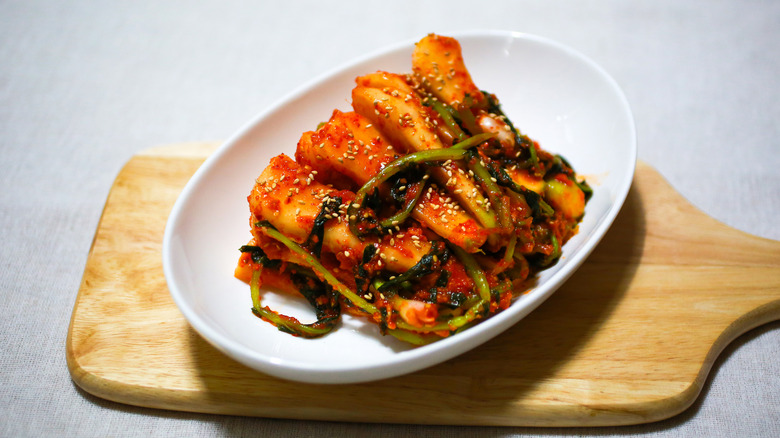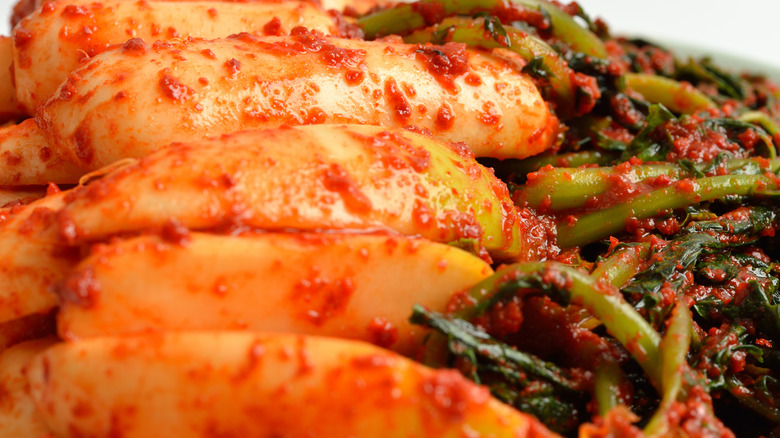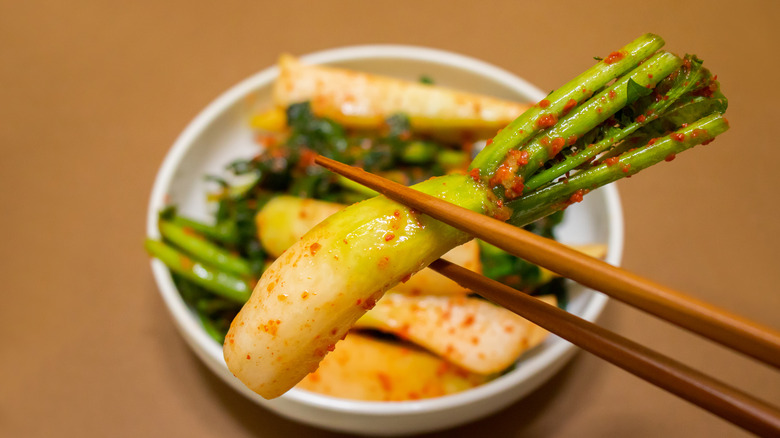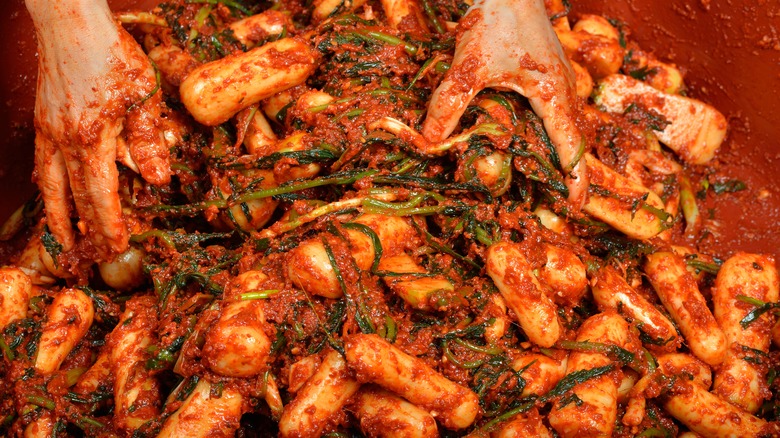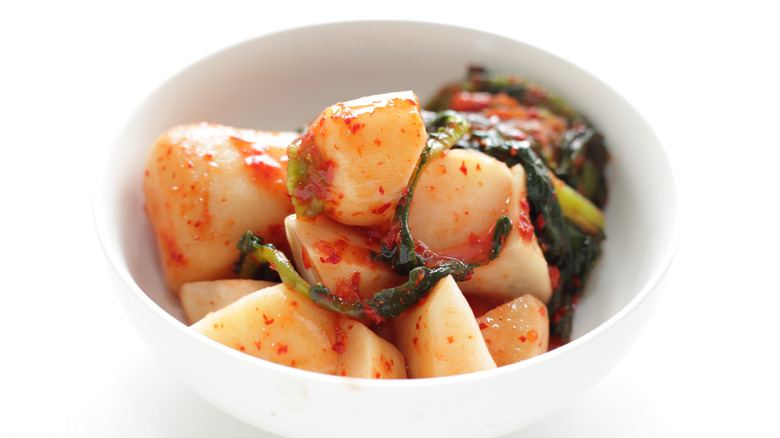What Makes Ponytail Kimchi Unique?
Ponytail kimchi may have a cute name, but this kimchi packs a flavor punch. While the word kimchi is most often associated with Napa cabbage transformed into a spicy and fermented Korean side dish, many kinds of kimchi use a variety of vegetables, including radishes, chives, and cucumbers. One of the most popular varieties of kimchi in South Korea is commonly called ponytail kimchi because of its appearance. Looking like what its name implies, ponytail kimchi (chonggak-kimchi) is made from a radish with its greens still attached, according to Maangchi. The specific type of radish used to make ponytail kimchi is called chonggak mu, which is a small radish, according to Korean Bapsang. Another characteristic of the radish is that it has long and leafy stems.
While the word ponytail may incorrectly conjure up images of girls, chonggak is named for boys and young men, according to Korean Bapsang, which says that chonggak means bachelor in Korean and refers to the ponytail that unmarried men would sport in the olden days. The radish, it is said, resembles a ponytail with its leafy stem. When the single men married, they would turn their long, braided hair into a bun, per Beyond Kimchee. The kimchi made from the chonggak radish is known by two names, Beyond Kimchee says. In addition to being called chonggak kimchi, it's also called altari mu kimchi, reflecting the other name for the radish — altiari.
A robust and spicy flavor
A dish reflects its components in taste and texture, which is the case with ponytail kimchi. Maangchi describes the chonggak radish as about 4 inches long with a firm texture, contrasting with its soft, leafy greens. Once the kimchi is made, it also has those same textures: crispiness and tenderness. This contrasting texture of ponytail kimchi sets it apart from other types of kimchi, per Crazy Korean Cooking, which describes it as surprisingly leathery. The kimchi tastes best after fermenting for a while because if it is too new and fresh, it can be spicy and bitter.
Beyond Kimchee describes the flavor of chonggak kimchi as being rich, especially after being fermented for a few days, to allow the flavor to develop. To achieve that flavor with more depth, Edible Cape Cod recommends allowing chonggak kimchi to ferment for a day or two in a container kept at room temperature before eating.
Simple ingredients to make complex flavor
Only a handful of classic Korean ingredients are needed for making ponytail kimchi, per Maangchi. They are chonggak mu radishes, kosher salt, onion, garlic, flour, sugar, fish sauce, green onions, and Korean hot pepper flakes (gochugaru). Crazy Korean Cooking specifies that sweet rice flour is best and suggests shrimp fish sauce instead of fish sauce. However, an anchovy sauce or a combination of shrimp fish and anchovy sauce can be used.
Korean Bapsang says a blend of fish sauce and salted shrimp (saeujeot) is preferred, and how much of each is used will affect how strong the taste is. If a milder flavor is desired, more salted shrimp should be employed than fish sauce. While chonggak radishes may not be common outside of South Korea, Maangchi said they could be found in Korean grocery stores, along with the other ingredients necessary for ponytail kimchi.
How to make ponytail kimchi
The first step to making ponytail kimchi is to clean the radishes and then prep them, per Korean Bapsang. While the stems are kept on the radish body, they can be trimmed, and the radish can also be cut in half if it's too thick.
The amount of salt used to brine the radishes varies and should be determined by how thick the radish is. It's also important to not oversalt the radishes, according to Korean Bapsang, because not all radish water should be extracted. The radishes should sit in the salt for about 2 to 4 hours, during which they are rotated. While the radishes sit in the brine, so a glutinous rice paste should be made, consisting of sweet rice powder and water, says Korean Bapsang. Using gloves, the seasoning can be added to the radishes until they are well coated.
To allow the kimchi to ferment, Maangchi says to store it in a glass jar or a plastic container at room temperature for a couple of days. As the kimchi ferments, the taste will become sour, as will its smell. The color of the greens will also become olive green. While the kimchi ferments, it's essential to keep it moist by taking some of the juice from the bottom of the container and adding it to the top, per Maangchi. After it's properly fermented, the kimchi can be kept in the refrigerator until ready to be eaten.
How to eat chonggak kimchi
While ponytail kimchi complements any meal, Crazy Korean Cooking recommends serving it with soup. One soup that goes well with chonggak kimchi is beef, and radish soup made with daikon radish, according to The Prudent Garden. Chonggak kimchi also works well as a side to steak and a bowl of rice.
Ponytail kimchi is often served whole, with the diner biting off pieces of the radish to enjoy, but it can also be cut into smaller pieces before being placed in a bowl, per Korean Bapsang. Every Bunny Eats writer Grace Hsui also says she prefers to cut the chonggak kimchi into smaller pieces before eating. She also chooses to allow the kimchi to ferment for about two weeks before enjoying it but says, in her opinion, the kimchi is best at three weeks. Should the kimchi get too sour, Hsui suggests turning it into kimchi jjigae.
